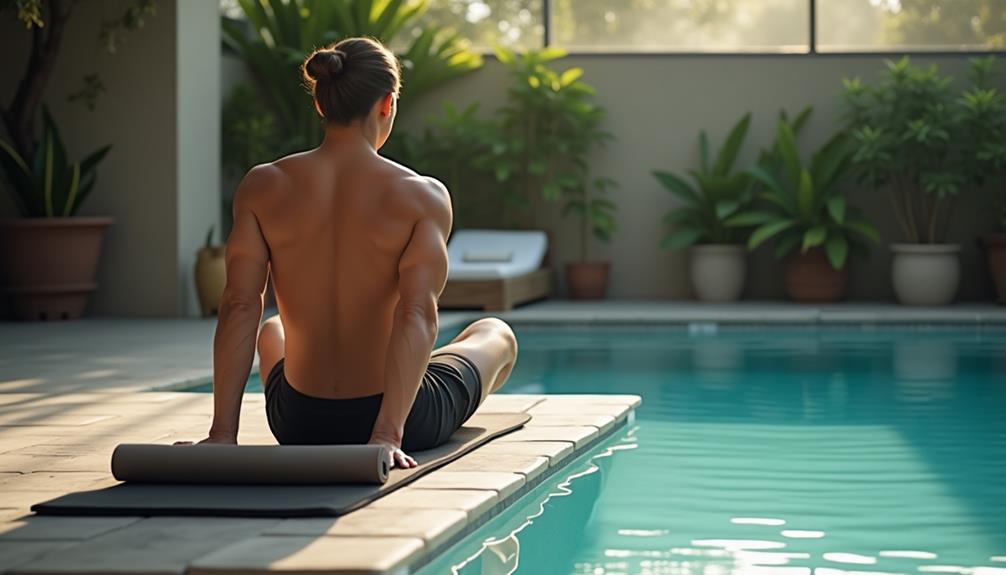To boost your gains, consider three active recovery tips. First, incorporate light cardio, like walking or cycling, for 20-30 minutes to enhance blood flow and help clear toxins from your muscles. Next, engage in stretching sessions to improve flexibility and reduce soreness; tools like gua sha can target specific muscles. Finally, prioritize sleep and hydration—aim for 7-9 hours of quality sleep and drink half your body weight in ounces of water daily. These practices will aid recovery and support your bodybuilding goals. There's even more to explore for optimizing your active recovery regimen.
Core Insights
- Incorporate 20-30 minutes of light cardio like walking or cycling to enhance blood flow and aid muscle recovery.
- Engage in regular stretching sessions to improve flexibility, reduce soreness, and support overall performance.
- Prioritize 7-9 hours of quality sleep each night to facilitate muscle repair and growth.
- Stay hydrated by drinking at least half your body weight in ounces of water daily to support nutrient transport.
- Use gua sha tools during stretching to target specific muscle groups and enhance recovery.
Incorporate Light Cardio

Incorporating light cardio into your routine can greatly enhance your active recovery. This doesn't mean you need to hit the treadmill for hours. Instead, aim for 20 to 30 minutes of low-impact activities like walking, cycling, or swimming. These exercises boost blood flow, helping clear out toxins and delivering oxygen to your muscles. During intense workouts, you may lose essential electrolytes through sweat. Electrolyte replenishment products can help maintain proper hydration and muscle function during your active recovery sessions.
You can easily fit light cardio into your day. Consider going for a brisk walk post-workout or cycling at a leisurely pace on your rest days. Listen to your body and adjust the intensity as needed. The goal is to keep moving without overexerting yourself. By adding light cardio, you'll support recovery, reduce muscle soreness, and prepare yourself for your next weightlifting session.
Engage in Stretching Sessions

Stretching sessions play an important role in your active recovery routine. They help improve flexibility, enhance blood flow, and reduce muscle soreness, making them essential for bodybuilders. Incorporating dedicated stretching into your week can lead to significant gains. For an even more effective recovery, consider using gua sha tools to target specific muscle groups and promote faster healing.
Here are some key benefits of stretching sessions:
- Increased flexibility: Helps you perform exercises with better form.
- Enhanced recovery: Aids in reducing muscle soreness after intense workouts.
- Improved posture: Helps counteract the effects of heavy lifting.
- Greater range of motion: Allows for more effective workouts.
- Stress relief: Promotes relaxation, benefiting both body and mind.
Make stretching a priority in your routine. It's a simple yet effective way to support your bodybuilding goals and keep your body performing at its best.
Prioritize Sleep and Hydration

After focusing on stretching, it's time to contemplate how prioritizing sleep and hydration can further enhance your recovery. Quality sleep is essential for muscle repair and growth. Aim for seven to nine hours each night to allow your body to recover fully. Create a sleep-friendly environment by limiting screen time before bed and maintaining a consistent sleep schedule. Quality supplements can also support your recovery efforts, especially those designed to promote restful sleep and muscle repair.
Hydration is equally pivotal. Water helps transport nutrients and supports metabolic processes. As a rule of thumb, drink at least half your body weight in ounces of water daily. Increase your intake during intense training or hot weather.
Frequently Asked Questions
How Often Should I Incorporate Active Recovery Into My Routine?
Incorporating active recovery into your routine is like letting a river flow through a rocky landscape. Aim for once or twice a week, allowing your muscles to rejuvenate while keeping your body engaged and moving.
What Specific Stretches Are Best for Bodybuilders?
For bodybuilders, incorporating dynamic stretches like leg swings, hip openers, and arm circles can enhance flexibility and mobility. Static stretches for major muscle groups post-workout, like hamstring and quad stretches, help aid recovery and prevent injury.
Can I Do Active Recovery on Rest Days?
Yes, you can absolutely do active recovery on rest days! Engaging in light activities like walking, stretching, or yoga helps reduce muscle soreness and improves circulation, making your overall recovery more effective and enjoyable.
What Are the Signs I Need More Recovery Time?
"Listen to your body." If you're feeling unusually fatigued, experiencing persistent soreness, or noticing a decline in performance, it's a clear sign you need more recovery time. Don't push through; prioritize rest for better results.
How Does Nutrition Impact My Recovery Process?
Nutrition plays an essential role in your recovery process. It fuels your muscles, replenishes glycogen stores, and repairs tissue. Prioritizing protein, healthy fats, and carbohydrates helps you recover faster and perform better in your next workout.

